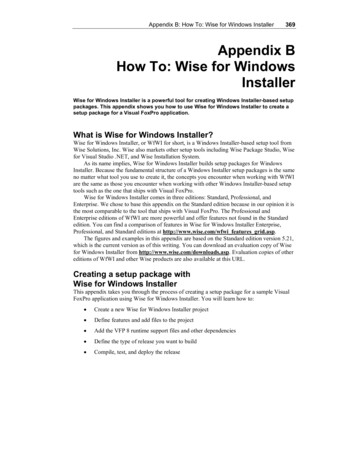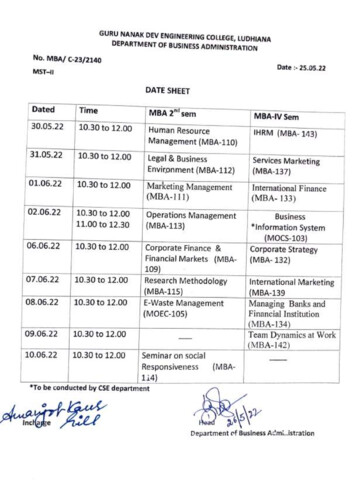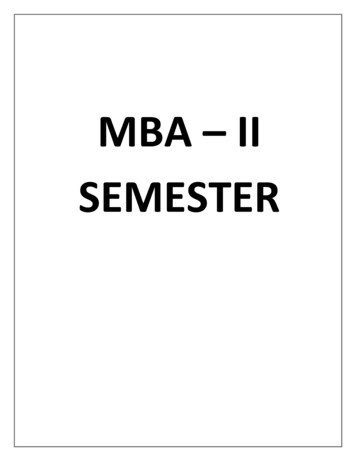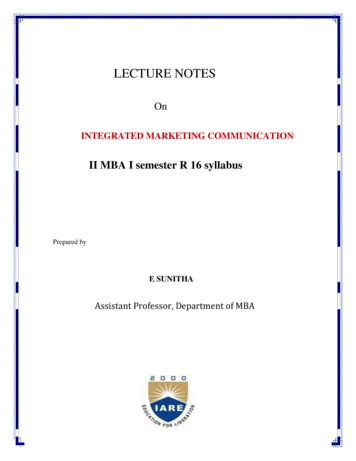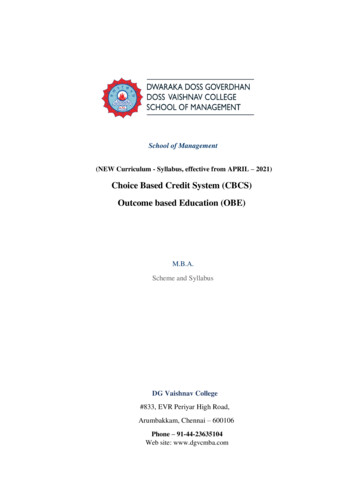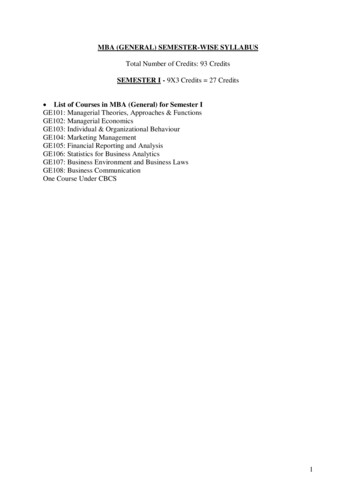
Transcription
MBA (GENERAL) SEMESTER-WISE SYLLABUSTotal Number of Credits: 93 CreditsSEMESTER I - 9X3 Credits 27 Credits List of Courses in MBA (General) for Semester IGE101: Managerial Theories, Approaches & FunctionsGE102: Managerial EconomicsGE103: Individual & Organizational BehaviourGE104: Marketing ManagementGE105: Financial Reporting and AnalysisGE106: Statistics for Business AnalyticsGE107: Business Environment and Business LawsGE108: Business CommunicationOne Course Under CBCS1
GE101MANAGERIAL THEORIES, APPROACHES AND FUNCTIONS(3 CREDITS)ObjectiveThe Objective of the paper is to provide an understanding of the basic management concepts /principles and their significance to the organization. The course also includes the contemporaryissues and perspectives in management.Unit-1 Management and Organization – Relationship between management theory andmanagement practice – Role of a manager – skills of a manager.Unit-2 Perspectives on Management and Development – Scientific management – Taylor,Taylor and Gilbreth. Human Relations approach Hawthorne experiments – Theory X andTheory X – Theory 2 – Behavioral approach – Contingency approach.Unit-3 Contemporary approaches to management theory – contributions of Tom Peters –Rosabest – Karter – Peter Lange – Prahlad and Sumantra Ghoushal. Comparative perspectiveson American, Japanese and European Approaches to management.Unit-4 Management processes and function – Nature and description of management process– Managerial functions – planning, organizing, directing, coordinating and controlling.Unit-5 Organizational processes – concept of power, Authority and be legation – emergenceof new organizational, model. Leadership – approaches – theories – transactional –transformational leadership – leader – manager.Unit-6 Contemporary Issues in management – social responsibility, ethics andenvironmental management. Perspectives on Indian Management - Management by values.Suggested Readings1. Weirich & Koontz (1996) Essentials of Management. New Delhi: TMH2. Paul Heresy & Ken Blanchard (1995) Management and Organizational behavior. NewDelhi: PHI3. Hawthorne V. Butler (1987) Organization and Management - Theory and Practice. NewDelhi: PHI4. Miner B. John (1990) Organizational Behaviour - Performance and Productivity. NewYork: Random House5. Stephen P Robins and M Coulter (2004) Management. New Delhi: PHI2
GE102MANAGERIAL ECONOMICS(3 CREDITS)ObjectiveThe objective of this paper is to provide the basic concepts in Managerial Economics.Unit-1 Basic concepts of Managerial Economics – Profits, revenue – costs – discounting –profit maximization – marginal analysis – regression analysis – objectives of the enterprise.Unit-2 Demand – Demand function – Law of demand, demand elasticity’s, demand estimationand forecasting.Unit-3 Production and Costs – Production Function – Employment decisions – cost curves inthe short and long run – estimating cost functions.Unit-4 Perfect competition – Output decisions of firms, equilibrium of the industry in theshort and long run – supply-demand analysis – effects of price control. Monopoly and simpleOligopoly – Price and output decisions under monopoly, discriminating monopoly, effects ofprice control, kinked demand curve hypothesis.Unit-5 Price practices – Cost based pricing, Competition oriented pricing, - Limit pricing –Peak load pricing – Life Cycle pricing.Suggested Readings1. Christopher R Thomas and S. Charles Murice (2005) Managerial Economics - Conceptsand Applications. New Delhi: Tata McGraw Hill.2. P.L. Mehta (2002) Managerial Economics - Analysis, Problems and Cases. New Delhi:Sultan Chand3. Watson and Getz (1995) Price Theory and its uses. AITBS4. Rahul A. Shastri (2000) Microeconomic Theory. Hyderabad: Universities Press (OrientLongman)3
GE103INDIVIDUAL AND ORGANIZATIONAL BEHAVIOUR(3 CREDITS)ObjectiveThe Objective of this paper is to acquaint the student with the behavioral nuances of individualand group on Organizations.Unit-1 Introduction to OB – Definition – Relationship with other fields – Theoretical frameworks – Environmental context – Globalization – Diversity and Ethics – Work behavior.Unit–2 Foundations of Behavior: Personality – Meaning – Role of heredity – Self-esteem –Self efficacy – Socialization process – Person – Situation interaction – Big 5 personality traits– Attitudes – Nature and dimensions of attitudes – Components of attitudes – Functions –Changing attitudes – Antecedents of work related attitudes job satisfaction – Outcomes –Commitments – Perception – Nature – Sensation Versus Perception – Sub processes –Perceptual selectivity – Organization- Social perception – Attribution – Stereotyping – Locusof control – Impression Management – Positive OB – Positive Psychology – Optimism –Dimensions – Emotional intelligence – Self efficacy.Unit–3 Work Motivation – Meaning – Primary motives – Secondary motives – Approaches– Content theories – Process theories – Contemporary Theories – Applications of theories inwork place – Job Design.Unit–4 Groups – Nature of groups – Dynamics of Informal groups – Dysfunctions of groupsand teams – Teams in modern work place.Unit–5 Interactive Conflict – Nature – Sources of conflict – Intra individual conflict –Interactive Conflict – Resolving conflicts – Negotiation – Skills – Management.Unit–6 Stress – Emergence of Stress – Causes – Copying mechanisms – PsychosomaticDisorders – Consequences – Managing Stress.Unit–7 Organizational Culture – Definition – Characteristics – Strong and Weak Cultures –How cultures start – Maintaining an uniform culture – Changing Organizational Culture.Unit–8 Challenges of Organizations in the Post Globalized EraSuggested Readings1. Fred Luthans (1998) Organizational Behavior. New Delhi: Mc Graw – Hill InternationalEdition2. Udai Pareek (2004) Understanding Organizational Behavior. New Delhi: OxfordUniversity Press3. K. Aswathappa (2005) Organizational Behavior Text cases games. New Delhi: HimalayaPublishing Company4. Schermerhorn, Hunt, Osborn (2001) Organizational Behavior. New Delhi: John Wiley &sons, Inc.4
GE104MARKETING MANAGEMENT(3 CREDITS)ObjectiveThe Objective of this course is provide the students a basic conceptual framework of theMarketing Principles and Practices in an organization:Unit-1 Fundamental of Marketing: Introduction – Marketing Concept – Philosophy –Marketing Environment Consumer and Industrial Marketing.Unit-2 Marketing Process and Framework: Elements of the Marketing Mix – PromotionalMix – Product Life Cycle (PLC).Unit-3 Market Analysis and Planning – Market Segmentation – Competitive analysis andMarketing Organizations and Control.Unit-4 Consumer and Industrial Buyer Behaviour – Model of consumer and industrialbehavior.Unit-5 Marketing Management in the New MillenniumSuggested Readings1. Kotler, Philip (1998) Principles of Marketing. New Delhi: Prentice Hall of India2. Mc Carthy, E. Jerome (1998) Basic Marketing : Richard D. Irwin Inc: Homewood, Illinois3. Neelamegham S (1998) Marketing in India, Cases and Readings. New Delhi: VikasPublishing House Pvt. Ltd.4. Panwar J.S. (1997) Marketing in the New Era. Sage Publications5
GE105FINANCIAL REPORTING AND ANALYSIS(3 CREDITS)Objectives:The objectives of this course is to familiarize the Students with the rudiments of AccountingCycle (as a basis for financial decision making). It will also equip the student with skills inanalyzing and interpreting financial StatementsUnit-1 Introduction to Accounting Cycle - Definitions – Journalizing – Ledger Posting –Subsidiary Books – Trial Balance – Profit and Loss Account – Balance Sheet.Unit-2 Basic Postulates of Accounting – Concepts and Conventions – GAAP – IFRS.Unit-3 Corporate Accounts – Special Characteristics - Preparation of Final Statements ofAccount.Unit-4 Financial Statement Analysis – Ratio Analysis – Liquidity – Leverage – Activity –Profitability – Implications and Interpretation.Unit-5 Financial Statement Analysis – Comparative Statements – Common-Size Statements– Trend Analysis – Inter–firm Comparison – Industry Analysis.Unit-6 Funds Flow Analysis – Concept of Fund – Statement of Changes in Working Capital– Statement of Changes in Financial Position – Cash Flow Analysis.Suggested Readings:1. Jain & Narang: Advanced Accountancy, Kalyani Publications, Ludhiana. LatestEdition Pandey I.M: Financial Management, Vikas Publishing, New Delhi, LatestEdition.2. Khan M. Y. & Jain P K: Management Accounting, Tata McGraw-Hill, New Delhi,Latest Edition.3. Sharma & Gupta: Management Accounting, Kalyani Publishers, Ludhiana.4. Singvi, N.M. & Ruzbeh J. Bodhanwala: Management Accounting Text and Cases .6
GE106STATISTICS FOR BUSINESS ANALYTICS(3 CREDITS)ObjectiveThis course helps students to understand and formulate managerial situations in a decisiontheoretic framework. They shall be exposed to fundamental optimization procedures andtechniques. Real life case studies are discussed to illustrate constrained and unconstrainedoptimization methods.Unit–1 Introduction: History; Subdivisions within Statistics; Data collection; Editing;Classification; Tabulation; Diagrammatic and Graphic representation of data.Unit–2 Measures of Central tendency and Dispersion: Arithmetic Mean; Geometric Mean;Harmonic Mean; Median; Mode, Standard Deviation; Skew ness; Kurtosis; Moments.Unit–3 Probability and Probability Distributions: Introduction to Probability: ProbabilityRules; Probabilities under Conditions of Statistical Independence; Probabilities underConditions of Statistical Dependence, Revising Prior Estimates of Probabilities: Bayes’Theorem; Random Variables; Use of Expected Value in Decision Making; The BinomialDistribution; The Poisson Distribution; The Normal Distribution.Unit–4 Correlation, Regression and Time Series: Estimation Using the Regression Line;Correlation Analysis; Making Inferences about Population Parameters; Using Regression andCorrelation Analysis: Multiple Regression and Correlation Analysis; Finding the MultipleRegression Equation; Variations in Time Series; Trend Analysis; Cyclical Variation; SeasonalVariation; Irregular Variation; A Problem Involving All Four Components of a Time Series;Time Series Analysis in ForecastingUnit–5 Index Numbers: Unweighted Aggregates Index; Weighted Aggregates Index; Averageof Relatives Methods; Quantity and Value Indices; Issues in Constructing and Using IndexNumbersUnit–6 Concepts of Sampling and Estimation: Random Sampling; Design of Experiments,Introduction to Sampling Distributions; Sampling Distributions in More Details; AnOperational Consideration in Sampling: The Relationship Between Sample Size and StandardError; Point Estimates; Interval Estimates: Basic Concepts; Interval Estimates and ConfidenceIntervals; Calculating Interval Estimates of the Mean from Large Samples; Calculating IntervalEstimates of the Proportion from Large Samples.Unit–7 Testing of Hypotheses and Analysis of Variance: Concepts Basic to the HypothesisTesting Procedure; Testing Hypotheses; Hypothesis Testing of Means When the PopulationStandard Deviation is Known; Measuring the Power of a Hypothesis Test; Hypothesis Testingof Proportions: Large Samples; Hypothesis Testing of Means When the Population StandardDeviation Is Not Known; Hypothesis Testing for Differences between Means and Proportions;Tests for Differences between Means: Large Sample Size, Small Sample Sizes; TestingDifferences between Means with Dependent Samples; Test for Differences betweenProportions: Large Sample Sizes; Analysis of Variance; Inferences about a PopulationVariance; Inferences about Two Population Variances7
Unit–8 Non-parametric tests: Chi-Square as a Test of Independence; Chi-Square as a Test ofGoodness of Fit: The Sign Test for Paired Data; Rank Sum Tests: The Mann-Whitney U Testand the Kruskal-Wallis Test; The One-Sample Runs Test; Rank Correlation; The KolmogorovSmirnov Test.Suggested Readings1.2.3.4.5.Richard I. Levin & David S. Rubin, Statistics for Management, PHI.1999, NewDelhiKishor S. Trivedi, Probability and Statistics with Reliability, Queuing andComputer Science Applications, John Wiley & Sons, Singapore, 2002John E. Freund & Ronald E. Walpole, Mathematical statistics, PH, New Jersey,1980E. L. Lehmann, Testing Statistical Hypotheses, John Wiley & Sons, New York,1986S. P. Gupta, Statistical Methods, Sultan Chand &Sons, New Delhi 1998.8
GE107BUSINESS ENVIRONMENT AND BUSINESS LAWS(3 CREDITS)ObjectiveThe objective of this paper is to sensitize the student about the business environment in theIndian context. The political, economic, legal and technological environment is also includedin the course.Unit-1 Business Environment: Concept, Nature and scope of Business Environment, GlobalBusiness Environment, Business Environment in the Indian context.Unit-2 Economic Environment : Types of economic policies, economic liberalization, fiscaland monetary policies and budget; WTO and international economy Industrial policy – TradePolicy – Economic Development and role of government – Privatization & Public SystemsManagement.Unit-3 Political & Legal environment: Political institutions – Legislature – executive –Judiciary interaction between political institutions and business, firm; legal framework ofbusiness; Company laws; Labor legislations: Consumer Protection Act, 1986.Unit-4 Technological Environment; Impact of Technology, Technology and Society; Trendsin Technology Management, Issues & Challenges.Unit-5 Social Environment: Business and Society: Social responsibility of Business; Socialpressures, groups and dimensions. Natural Environment: Environmental aspects in business –Environmental hazards: Government role and interventions.Unit-6 Indian Contract Act – 1872. Sale of Goods Act 1930 - - Negotiable Instruments Act1881 – Companies Act – 1956 – Consumer Protection Act and Cyber Laws. Role of MRTPAct. Competition Law Environmental Act.Suggested Readings1) Ashwathappa (2006) Essentials of Business Environment. Bombay: HimalayaPublishing House2) Francis Cherunilam (1993) Business Environment. Bombay: Himalaya PublishingHouse, Bombay3) Agarwal, Raj (2002) Business Environment, New Delhi: Excel Books4) Cherunilam, Francis (1997) Business Environment, Mumbai: Himalaya Publishing House5) Mathew M.J. (2003), Business Environment: A study of socio cultural, economic and legalenvironment in business, Jaipur RBSA Publishers.9
GE108BUSINESS COMMUNICATION(3 CREDITS)ObjectiveTo develop application of written, oral and interpersonal communication skills and familiarizethe students with gaps for personal effectiveness and ways to overcome them.Unit-1 Fundamentals of Communication – Introduction, Understanding Communication, thecommunication process, Barriers to communication, the Importance of Communication in theWorkplaceUnit-2 Expressive Communication – Written Communication, Business Letters. E-mail,Memo, Reports and Proposals, Oral Communication, Presentation Skills, Meetings, GroupDiscussion, Managerial Speeches, Interviews, Non-verbal Communication, Kinesics,Proxemics, VoiceUnit-3 Receptive Communication Skills – Listening, Importance, Types, Barriers, ImprovingListening, Reading Body LanguageUnit-4 Organizational Communication – Internal, Types, Channels, Diversity andIntercultural Communication, External Communication, Types, Channels, Use of TechnologyUnit-5 Interpersonal Communication – Interpersonal needs, Reducing Misunderstandings,Rapport Building, Negotiation Skills, Johari Window, Transactional AnalysisUnit-6 Employment Communication – Resumes and Cover Letters, Introduction, Writing aResume, Writing Job Application Letters, Group Discussion and InterviewsReferences1. Bovee and Thill: Business Communication Today, McGraw-Hill, Second Edition2. Guffey M. E.: Business Communication Process & Product, Thompson, South-Western3. Level D.A: Managerial Communications, Business Publications, Plano, Texas4. Pradhan and Pradhan: Business Communication, Himalayan Publishing House5. Seely J, Oxford Writing and Speaking, Oxford6. Raman and Singh: Business Communication, Oxford University Press, New Delhi10
SEMESTER II - 9X3 Credits 27 Credits List of Courses in MBA (General) for Semester IIGE201: Business Analytics for Decision MakingGE202: Operations ResearchGE203: Human Resource ManagementGE204: Strategic MarketingGE205: Financial ManagementGE206: Operations ManagementGE207: Research Methodology for ManagersGE208: Cost and Management AccountingOne Course under CBCSGE201BUSINESS ANALYTICS FOR DECISION MAKING(3 CREDITS)The objective of this course is to provide the students an exposure to the role of analytics inbusiness decision making. The students also learn working with R software which is quitepopular and extensively used in the area of analyticsUnit-1 Introduction to Business Analytics, Types of data, Integrating Analytics withbusiness, Business Analytics for Competitive Advantage, Descriptive, Predictive, andPrescriptive Analytics, DashboardsUnit-2 Business Analytics Process CycleUnit-3 Machine Learning, Supervised Learning and Unsupervised Learning, Clustering &Segmentation, Affinity/Association Analysis, Data Reduction, Visual Analytics and datavisualizationUnit 4: Market basket Analysis, Text Analytics, Spreadsheet Modelling,Unit 5: Introduction to Big Data, Master Data ManagementSuggested Readings:1. Analytics at Work by Thomas H. Davenport, Jeanne G. Harris and Robert Morison,Harvard Business Press, 20102. Getting Started with Business Analytics: Insightful Decision-Making by DavidHardoon, Galit Shmueli, Chapman & Hall/CRC, 20133. Business Intelligence: A Managerial Approach by Efraim Turban, Ramesh Sharda,Dursun4. Delen and Daid King, Pearson Publication, 20125. Business Intelligence Making Decision through Data Analytics, Jerzy Surma, BusinessExpert Press, 20116. Successful Business Intelligence: Secrets to Making BI a Killer App by Cindi Howson,Tata McGraw Hill Edition, 201211
GE202OPERATIONS RESEARCH(3 CREDITS)Objective:The objective of the course is to provide exposure to the major tools and techniques ofOperation Research (OR), and to create awareness and appreciation about the application ofOperation Research in functional areas of Management.Course Outline: [Approximate number of lectures per topic]Unit-1 Introduction to Operation Research and Modeling, Definitions of OR, Evolution,Scope and Applications in Business [4]Unit-2 Linear Programming, Models, Assumptions of LPP, Formulation, Graphical Method,Simplex method, Dual Simplex Method and Duality, Sensitivity Analysis [ 8]Unit-3 Transportation Problem, Initial solution methods, Degeneracy, MODI method,Transshipment problem, Assignment Problem, Hungarian method, Unbalanced problems, TheTravelling- Salesman problem [8]Unit-4 Statistical Decision Theory, Criteria for Decision Making under risk and uncertainenvironments, concept of Utility , Expected Monetary Value, EVPI, Decision Tree, Bayesianapproach and Utility theory, Markov Analysis [6]Unit-5 Game theory, Zero sum game, Saddle point, pure strategies, mixed strategies,Dominance, Graphical Method, Matrix method, Algebraic Method [6]Unit-6 Sequencing Problem, Johnson’s Rule, “n” jobs through two/more machines, Two jobsthrough ‘m’ machines, Replacement Problem, Queuing theory, Queuing system, Models andapplications, Simulation, Monte Carlo simulation, Business Applications [8]Suggested Readings:1. Richard .I. Levin, David. S. Rubin: Quantitative approaches to Management, Mc GrawHill International Book co.1992.2. Barry Render, Ralph M. Stair, Jr., Michael E. Hanna: Quantitative Analysis forManagement, Pearson Education.2008.3. Hamdy A. Taha: Operations Research: An Introduction, Dorling Kindersley, 2008.4. S. D. Sharma: Operations Research, Kedar Nath Ram Nath & Co., 20065. Kanthi Swarup, Gupta P K, Man Mohan, Sultan Chand & Sons, 2008.12
GE203HUMAN RESOURCE MANAGEMENT(3 CREDITS)ObjectiveThe objective of this course is to introduce the concept of Human Resource in Managementand provide insights into the functional dimensions of human resource managementUnit-1 Human Resource Management-concept, nature, scope, function perspectives,strategic HR in changing environment-Challenges of HR.Unit-2 Employee planning – Need for HR planning, determining the demand for workforce, predicting the future supply, replacement charts, HR planning in a Globalized era.Unit-3 Work Analysis and Design- Methods of Job Analysis, Job Description, JobSpecifications, Job Evaluation.Unit-4 Recruitment and selection procedures- Recruitment sources-e-recruitment-stepsin selection procedures, hiring decisions, placement procedures-process of induction,socialization process, global placement, transfers, promotions, handling separations,downsizing.Unit-5 Training and Development- Need and Importance of Training-Methods andEvaluation of Training, Career Management-Career Development and planning, CareerSuccess.Unit-6 Performance Appraisal- Methods-Purpose Traditional and Modern ApproachesPerformance Management- Competency Management.Unit-7 Employer- Employee Relations- Industrial Relations, Nature, Importance, TradeUnions in a liberalized era. Collective bargaining, workers participation movement,managing employee safety and health.Unit-8 Contemporary Issues in HRM- Diversity Management, Cross-CulturalManagement, Ethics in HRM, Human Resource Information System.Appropriate cases studies will be discussedSuggested Readings:1) P. Jyothi and Venkatesh (2005) D.N. Human Resource Management, New Delhi: OxfordUniversity Press.2) Wayne F Cascio (1998) Managing Human Resources, New Delhi: Tata Mc.Graw Hill.3) John Walton (1999) Strategic Human Resource Development, New Delhi: Prentice Hall.4) Arun Monappa & Merukh Engineer (1999) Liberalization and Human resourceManagement- Challenges for the corporations of Tomorrow, New Delhi: Sage publications.13
GE204STRATEGIC MARKETING(3 CREDITS)Objective:The objective of this course is to provide a conceptual and practical framework of marketingmanagement in an organization and develop analytical and decision making skills.Unit-1 Changing marketing issues and trends- Delivering Customer Value and Satisfaction.Relationship Marketing.Unit-2 Analysis of consumer / organizational markets - Model of consumer behavior.Factors influencing Buyer behavior. Buying decision process / stages.Unit-3 Analysis of competition - Identifying and analyzing competitors. Designing thecompetitive intelligence system. Strategy formulation.Unit-4 Marketing decisions - Managing Product Lines and Brands. Price setting andresponding to pricing changes. Channel design and management. Direct marketing andmarketing of services. Marketing communication. Sales force managementUnit-5 Marketing organization and control – Techniques and Strategies.Suggested Readings1. Philip Kotler (1994) Marketing Management. New Delhi: Prentice Hall2. Georg Fisk 9 1986) Marketing Management. New Delhi: Praeger3. Joseph P. Goiltinam and Gordan W. Paul (1985) Marketing Management: Strategies andPrograms. New Delhi: McgrawHill4. Rajan Saxena (2002) Marketing Management . New Delhi: TMH14
GE205FINANCIAL MANAGEMENT(3 CREDITS)Objective:To Provide an Insight into the broad Framework of Financial ManagementTo Impart the Skills Necessary for Making Financial DecisionUnit-1 Overview of Financial Management-Functions of financial management – ProfitMaximization – Wealth Maximization – Organization of finance function - Time Value ofMoney – Future Value – Present Value - Single flow - Annuity Flow- Multiple compoundingperiods – Doubling Period – Sinking Fund Factor etc.Unit-2 Investment Decision – Traditional - Discounted cash flow Techniques - Risk Analysisand Real Options in Investment Decision.Unit-3 Concept of Cost of Capital - Component cost and overall Cost of capital – Cost of Debt– redeemable and irredeemable – Cost of Preference – Cost of Equity – Internal and External –Weighted Average Cost of Capital – Book Value – Market Value Weights.Unit-4 Capital Structure Decision – Sources of Finance – Debt – Equity – Preference – Hybrid- Leverage – Operating leverage – Financial Leverage – Combined Leverage – FinancialBreakeven Point – Theories – Net Income Approach – Net Operating Income Approach – MMApproach – Traditional Approach - Practical - determinants of capital structure.Unit-5 Dividend Decision – Theories – Modigliani and Miller Approach – Walter Model –Gordon Model – Dividend Policy and Share Valuation – Stock Splits – Bonus Shares – PracticalAspects of Dividend Policy – Corporate Dividend Behaviour.Unit-6 Working Capital Management – Overall Considerations – Duration of Operating Cycle– Investment in Current Assets – Management of Individual Components – Cash Management– Receivables Management – Inventory Management – Current Asset Financing.Books Recommended:1. James C.Van Horne, Financial Management &Policy, Prentice Hall of India, NewDelhi, Latest Edition.2. Eugene H Brigham, Fundamentals of Financial Management, Dryden Press, New York,Latest Edition.3. Pandey. I.M, Financial Management, Vikas Publishing House, New Delhi, LatestEdition.4. Khan M.Y& Jain P.K. Financial Management, Tata McGraw Hill, New Delhi LatestEdition.5. Rama Moorthy V.E., Working Capital Management, IFMR, Chennai, 1978.6. Prasanna Chandra, Financial Management Theory & Practice, Tata McGraw Hill LatestEdition.15
GE206OPERATIONS MANAGEMENT(3 CREDITS)Objective:This course attempts to help the students to learn operations management systems and analyzeissues pertaining to management of productivity, technology and facilities. This course willalso focus on concepts and policies relating to operations planning and control and managementof materials. It highlights integrative perspectives of the operations management function.Course Outline: [Approximate number of lectures per topic]Unit 1 Introduction: Production/Operation system and process, Product design, Processdesign [6]Unit 2 Facilities Management, Location of facilities, Productivity, Capacity planning, Layoutof facilities, and JIT [6]Unit 3 Operations planning and control: Forecasting, Aggregate Planning, Mass andcontinuous production systems, Lean Manufacturing, Material Requirements Planning, andMaster Production Schedule [8]Unit 4 Management of Technology: Role and importance, Technology change, TechnologyLife Cycle, Technological transformation, Technological alternatives and Technologyassessment [8]Unit 5 Materials Management: Planning and procurement of materials, Inventory planningand control, Economic Order Quantity, Replacement Problem [8]Unit 6 Introduction to Project Management, Network analysis and Supply ChainManagement [4]Suggested Readings:Textbooks:1. Lee. J.Krajewski & P.Ritzman, Operations Management- Strategy and Analyses, 6thEdition, Pearson Education, 2000, Delhi.2. R.Pannerselvam, Production and Operations Management, Prentice’ Hall of IndiaPrivate Limited, 2005, New Delhi.3. Joseph S. Martinich, Production and Operations Management, An applied ModernApproach, John Wiley & Sons, 2002, Delhi.4. S.N.Chary, Production and Operations Management, Tata Mc Graw Hill, 1995, NewDelhi.5. Gopal Krishnan , Hand Book of Materials M6. Management, PHI, 1997, New Delhi.7. Jack R Meredith & Samuel J. Mantel, Jr. Project Management, John Wiley & Sons,2000, Delhi.8. Chopra. S. and Meindl.P Supply Chain Management: Strategy, Planning & Operations,Prentice’ Hall of India Private Limited, 2005, New Delhi.16
GE207RESEARCH METHODOLOGY FOR MANAGERS(3 CREDITS)Objective:The objectives of the course is to enable the students in developing the most appropriatemethodology for their research studies and make them familiar with the art of using differentresearch methods and techniques.Unit-1 Introduction to Research- Nature, Objectives, Types, Characteristics, Problems,Techniques and defining the problem.Unit-2 Research design- Meaning, Purpose, Principles and developing a research plan.Unit-3 Sampling design, Measurement and Scaling techniques and psychological testing.Unit-4 Data collection- Preparation of data collection instruments, Interviews, Observation,Participatory Learning Appraisal and problems in collection of data.Unit-5 Data analysis: Analysis of variance, Discriminant analysis, Factor analysis, Clusteranalysis, conjoint analysis, Excel and Statistical Package for Social Sciences (SPSS).Unit-6 Report writing: Interpretations, Inferences, Generalizations and characteristics of goodreport.References1. Donald R. Cooper & Pamela S. Schindler (1999) Business Research Methods. New Delhi:Tata Mc Graw Hill2. Krishna Swamy and Ranganatham (2005) Methodology of Research in Social Sciences.Mumbai: Himalaya Books3. Levin, R. I. and Rubin, D. S. (2001) Statistics for Management. New Delhi: PHI4. Verenson, M. L. and Levine, V. N. (1996) Basic Business Statistics. New Jersey: PrenticeHall5. Berry, W. D. (1985) Multiple Regression in Practice. Beverly Hills: Sage17
GE208COST & MANAGEMENT ACCOUNTING(3 CREDITS)Unit-1 Marginal Costing and Break-even Analysis – basic concepts, marginal costing andabsorption costing, cost-volume-profit analysis, break-even analysis, limitations of breakeven analysis, differential cost analysis and relevant cost analysis, applications formanagement decision making (simple types)Unit-2 Standard Costing – concepts/uses and setting of standard cost accounting methods,computation of simple cost variances, relationship of standard costing and budgetary control,possible reasons for variations in costsUnit-3 Uniform Costing – inter-firm comparison, cost reduction, value analysis/engineeringincluding value managementUnit-4 Functional-based planning and control- budgeting-nature, administration andeffectiveness, budgeting cycle, activity-based budgeting, Kaizen-approach, ZBB,performance budgeting, responsibility centres and financial control, nature and roleresponsibility centres, accounting and evaluation of responsibility centres, measuring theperformance of investment centre – ROI, RI, EVA Tran
MBA (GENERAL) SEMESTER-WISE SYLLABUS Total Number of Credits: 93 Credits SEMESTER I - 9X3 Credits 27 Credits List of Courses in MBA (General) for Semester I GE101: Managerial Theories, Approaches & Functions . GE104: Marketing Management GE105: Financial Reporting and Analysis GE106: Statistics for Business Analytics GE107: Business .
